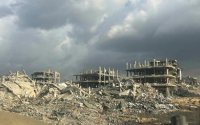15 June 2004Znet
I thought it was terrible. I was wrong. It is far, far worse! - These words sum up my feelings at that moment.
I was standing on a hill overlooking the infamous Kalandia checkpoint.
Below me was a narrow road, packed with Palestinians in the blazing sun, 30 degrees centigrade in the shade (but there was no shade) trudging towards the checkpoint. Very soon this road will be transformed. It will be widened to three lanes and be reserved for Israelis: on both sides of it, 8-meter high walls will spring up. It will allow the settlers of the Jordan valley to reach Tel-Aviv in about an hour. The Palestinians living on either side will be cut off from each other.
This is a small part of the new reality that is rapidly being created on the West Bank and that is changing the country we knew and loved beyond recognition.
I was standing near the edge of a-Ram. Once this was a small village on the outskirts of Jerusalem, on the road north to Ramallah. Since successive Israeli governments have prevented the Palestinians in East Jerusalem from building new homes, the severe overcrowding has forced a mass exodus to a-Ram, which has grown into a town of 60 thousand inhabitants. Most of them are officially still Jerusalem residents, carrying the blue identity cards of inhabitants of Israel. This allows them to come to Jerusalem, a drive of 10 minutes, work there, tend to their businesses, go to the hospitals and the universities there.
This is about to stop. Along the age-old road from Jerusalem to Ramallah (leading on to Nablus, Damascus and beyond) construction of the 8-meter wall is due to start any minute now - not across the road, but along the middle of the road, the full length of it. The inhabitants of a-Ram, east of the wall, will not only be completely cut off from Jerusalem, but also from all the townships and villages to their west - their relatives, the schools which thousands of their children attend, their cemetery and their places of work. A small part of a-Ram remains outside the wall and will be cut off from the main part of the town in which they live.
But this is only part of the story. Because the wall (or in some places a barrier, consisting of a fence, trenches and roads) will completely surround a-Ram from all sides. The sole exit from this walled-in area will be a narrow bridge connecting it with the adjacent area to its east, consisting of several Palestinian villages, which will be surrounded by another barrier. This enclave will have a narrow exit to the Ramallah enclave. Through this it will be possible for a person from a-Ram to reach Ramallah, God willing, by a roundabout route of some 30 kilometers, instead of the ten minutes or so it took before the occupation.
A few kilometers to the west of a-Ram lies a group of villages centered around Bidou (where five Palestinians have been killed so far in protests against the wall). This area is rapidly becoming another enclave, completely surrounded by a separate barrier. The only way out will be a tunnel to be built under road No. 443 - the settlers' road of which the section I mentioned before will become part. All existing roads to Bidou have long since been cut off by trenches or piles of dirt, one can enter only at one spot controlled by a checkpoint. This will cease to exist.
If a villager from Bidou has some business in a-Ram, he will have to go through the tunnel to Ramallah, turn to the enclave east of a-Ram and enter a-Ram by the narrow bridge, a semicircle of about 40 kilometers instead of a drive of a few minutes.
A-Ram will be especially hard hit. Because of its location, it has developed in the last few years into a kind of transshipment point for goods travelling from Israel to the West Bank and vice versa. Israelis and Palestinians do business there. All this will end with the wall. The means of livelihood for many of its 60 thousand inhabitants will disappear.
This is only one example of what is happening now all over the West Bank, turning it into a crazy quilt of walled-in enclaves, "connected" by bridges, tunnels or special roads, which can be cut off at any moment at the whim of the Israeli government or of a local army officer - and, all around them, roads-for-Israelis-only, expanding settlements and military installations. Every Palestinian town - Jenin, Nablus, Tulkarm, Kalkilia, Bethlehem, Hebron and others - will become the "capital" of a tiny enclave, cut off from all the others, from their "hinterland" and villages, except by tortuous roundabout routes. Fifty-five percent of the West Bank will be Israeli, the Palestinian enclaves will amount to 45% (about 10% of historical Palestine).
This is no longer just a nightmarish future prospect - it is happening now, visible to the naked eye, while Sharon babbles about a "disengagement" to happen sometime in the future in one small part of the occupied territories.
Practically no Israeli has any idea about all this. It may be happening one kilometer from his home (in Jerusalem, for example), but it might as well be on far side of the moon. The media are not interested, nor is the world.
This is the peace Sharon has been dreaming about. This is the "Palestinian State" George Bush promised. This is a cornerstone of the new democratic Middle East.
It will lead, of course, to bloodshed on an unbelievable scale. No people on earth will submit to such a life. For thousands and thousands of young Palestinians, a martyr's death will be preferable.
And sometime in the future this awful structure will be torn down, like the Berlin wall, which, evil as it was, was much less inhuman. As always, after much suffering, the human spirit will prevail.






